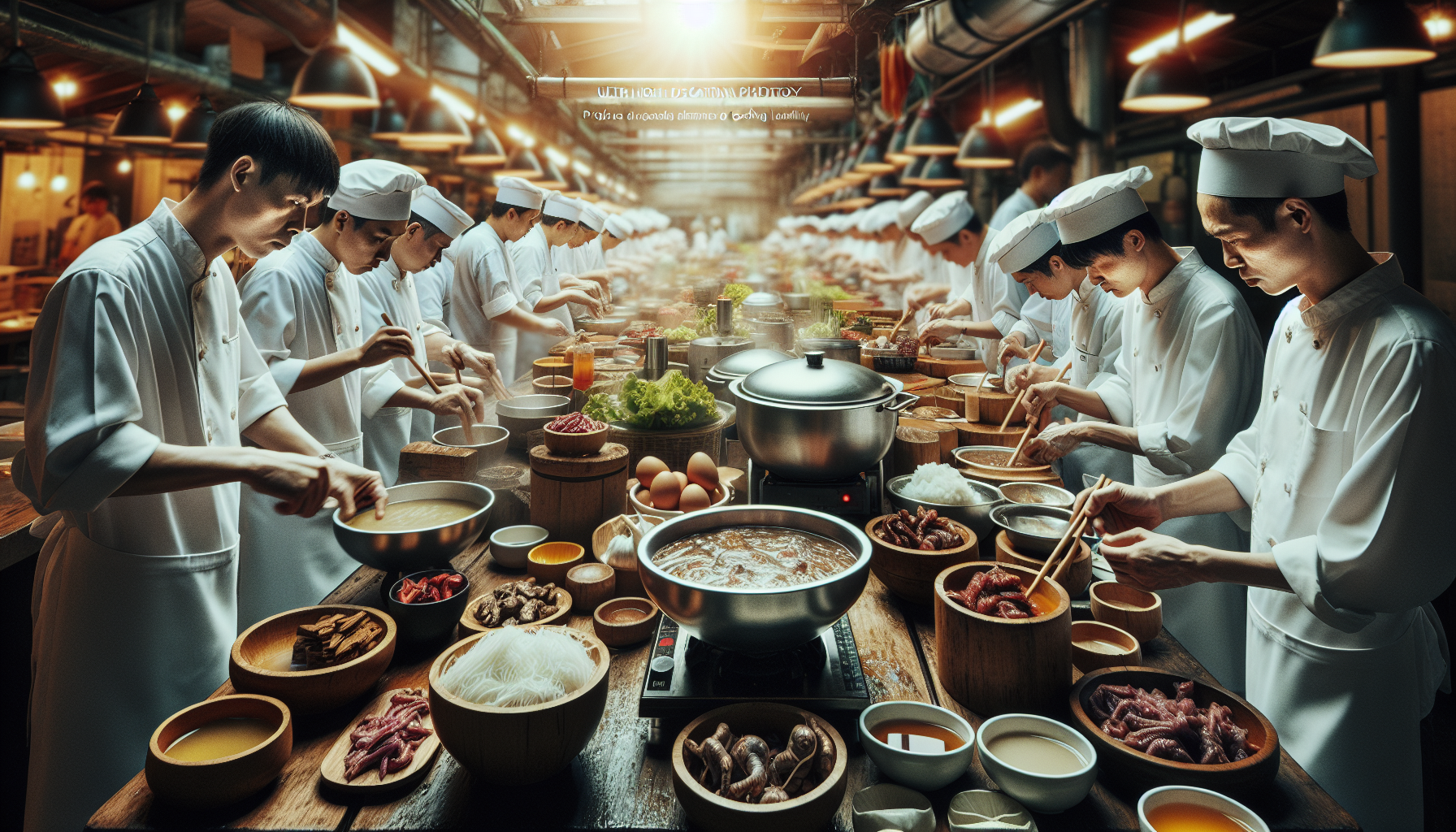The Importance of Inspiration in Culinary Creativity
The Importance of Inspiration in Culinary Creativity
When it comes to culinary creativity, inspiration plays a vital role in shaping the dishes we create. As a chef in learning, it’s important to constantly seek out new sources of inspiration to keep your creative juices flowing and your dishes fresh. In this article, we will explore the significance of inspiration in culinary creativity and how it can elevate your dishes to new heights.
1. Sparking Imagination
Inspiration acts as a catalyst for imagination, giving chefs the drive to experiment with new flavors, ingredients, and techniques. Whether it’s a beautiful ingredient at the farmer’s market, a stunning food photograph, or a conversation with a fellow chef, inspiration ignites the spark that fuels culinary creativity. It opens up a world of possibilities and encourages chefs to think outside the box, resulting in unique and innovative dishes.
2. Enhancing Flavor Profiles
Seeking inspiration from different cuisines and cultures can greatly enhance your flavor profiles. Exploring the bold spices of Indian cuisine, the delicate balance of Japanese flavors, or the comforting aromas of Italian cooking can help you integrate new and exciting tastes into your dishes. By drawing inspiration from diverse culinary traditions, you can create harmonious flavor combinations that wow your diners and elevate your culinary creations to a whole new level.
3. Presenting Food as Art
Culinary creativity goes beyond just taste; it extends to the visual presentation of your dishes. Inspiration can come from various sources, such as nature, art, or fashion, and can help you transform your plates into beautiful works of art. Whether it’s arranging ingredients in a visually appealing way, playing with different colors and textures, or experimenting with plating techniques, inspiration allows you to showcase your culinary skills and present food as a form of art.
4. Fostering Innovation
Inspiration is the driving force behind culinary innovation. It pushes chefs to push the boundaries and challenge traditional norms. By seeking inspiration from different industries, such as technology or fashion, chefs can bring new ideas and techniques to the culinary world. This cross-pollination of ideas leads to exciting innovations, such as molecular gastronomy or fusion cuisine, which push the boundaries of what is possible in the kitchen.
5. Creating Memorable Experiences
Ultimately, the goal of culinary creativity is to create memorable experiences for diners. Inspiration plays a vital role in achieving this. By infusing your dishes with inspiration, you can create unique flavor combinations, stunning presentations, and innovative techniques that leave a lasting impression on your guests. Whether it’s a birthday celebration, a romantic date, or a special occasion, inspired dishes will help you create unforgettable dining experiences.
In conclusion, inspiration is essential in culinary creativity. It helps chefs spark their imagination, enhance flavor profiles, present food as art, foster innovation, and create memorable dining experiences. By constantly seeking out new sources of inspiration, chefs can elevate their dishes and leave a lasting impact on the culinary world.
Exploring the Role of Ingredients in Culinary Innovation

When it comes to culinary innovation, the role of ingredients cannot be understated. Ingredients form the foundation of every dish, and chefs have been pushing the boundaries of creativity by exploring new and unique ingredients to elevate their culinary creations to new heights. In this article, we will delve into the importance of ingredients in driving culinary innovation and the various ways in which chefs are experimenting with them.
The Power of Ingredients
Innovation in the culinary world begins with ingredients. The right combination of flavors, textures, and aromas can create a memorable dining experience. Chefs are constantly searching for new ingredients that can add that wow factor to their dishes. Whether it’s a rare tropical fruit, an exotic spice, or a locally sourced vegetable, unique ingredients have the power to transform a dish from ordinary to extraordinary.
Exploring New Tastes
One way chefs are enhancing their culinary creations is by exploring new tastes through ingredients. They experiment with different flavor profiles, incorporating unexpected ingredients to create complex and intriguing dishes. For example, blending savory and sweet flavors or pairing ingredients with contrasting tastes can create an exciting and harmonious combination that surprises the palate.
Local and Seasonal Ingredients
Culinary innovation is also driven by a focus on using local and seasonal ingredients. Chefs are increasingly incorporating ingredients grown or sourced from their local communities, showcasing the unique flavors of the region. This not only supports local farmers and producers but also allows chefs to experiment with ingredients that are at their peak freshness, resulting in vibrant and flavorful dishes.
Ingredient Substitutions
Another area where ingredients play a vital role in culinary innovation is through substitutions. Chefs are constantly finding creative ways to replace traditional ingredients with alternatives, whether it’s due to dietary restrictions, sustainability concerns, or simply to add a twist to a classic dish. Ingredient substitutions can lead to new and unexpected flavor combinations, sparking innovation in the culinary world.
The Role of Technology
Technology has also played a significant role in culinary innovation when it comes to ingredients. Chefs now have access to a wide range of ingredients from all over the world, thanks to advancements in transportation and logistics. They can experiment with ingredients that were previously inaccessible, opening up new possibilities for creativity and innovation in the kitchen.
Innovation in the culinary world is driven by a constant exploration of ingredients. Chefs are always on the lookout for new, unique, and exciting ingredients that can take their dishes to the next level. From experimenting with new tastes to utilizing local and seasonal ingredients, and even exploring ingredient substitutions, the possibilities for culinary innovation are endless. So, the next time you dine out, pay attention to the ingredients on your plate, as they are the secret behind the innovative and groundbreaking dishes served by talented chefs around the world.
The Influence of Cultural Diversity on Culinary Creations

Cultural diversity plays a crucial role in shaping culinary creations around the world. As different cultures bring their unique traditions, ingredients, and cooking techniques, the culinary landscape becomes an amalgamation of flavors, making it an exciting and vibrant journey of tastes and textures. In this article, we will explore how cultural diversity influences culinary creations, and the incredible results it produces.
A Fusion of Flavors
One of the most remarkable outcomes of cultural diversity in culinary creations is the fusion of flavors. As different cultures interact and borrow from each other, new and exciting combinations emerge. For example, the fusion of Mexican and Asian cuisine has given birth to the popular trend of “Tex-Mex,” incorporating elements from both cultures to create dishes with a unique twist. The blending of flavors creates a harmony that delights the taste buds and represents the beautiful diversity of our world.
Exploration of Ingredients
Cultural diversity enriches culinary creations by introducing new and exotic ingredients. Every culture possesses its own unique ingredients that are integral to their traditional dishes. When these ingredients are shared and integrated into different cuisines, they open up new possibilities for culinary exploration. For instance, the use of spices like turmeric and garam masala from Indian cuisine has found its way into Western dishes, adding depth and complexity to their flavors. Such cross-cultural exchange elevates culinary experiences to new heights.
Preservation of Culinary Heritage
Cultural diversity preserves the richness and authenticity of traditional culinary practices. As different cultures embrace their culinary heritage, traditional recipes and cooking techniques are passed down through generations. This ensures that ancestral traditions are not forgotten, and the unique identity of each culture is maintained. By valuing diversity, we are able to celebrate the extraordinary culinary legacies that have shaped our world.
Exploration and Innovation
With cultural diversity comes an opportunity for culinary exploration and innovation. Chefs and home cooks alike are continually inspired by different cuisines from around the world. By challenging traditional culinary norms and experimenting with flavors, they create new dishes that push boundaries and captivate diners. The integration of diverse cooking techniques and ingredient combinations leads to innovative culinary creations that showcase the limitless potential of human creativity.
Cultural diversity is a driving force behind the evolution and development of culinary creations. Through the fusion of flavors, exploration of ingredients, preservation of culinary heritage, and the constant pursuit of exploration and innovation, cultural diversity leaves an indelible mark on our culinary experiences. Embracing cultural diversity allows us to savor the richness and beauty of our world through the art of cooking. So, let’s celebrate and cherish the influence of cultural diversity on culinary creations.
The Creative Process: From Concept to Plate

Creating a culinary masterpiece is not just about following a recipe. It involves a creative process that starts from concept development and ends with a beautifully plated dish. In this article, we will explore the stages of the creative process in the world of cooking and how chefs bring their imaginative ideas to life on a plate.
1. Finding Inspiration
The first step in the creative process is finding inspiration. Chefs draw inspiration from various sources such as nature, art, travel, or even childhood memories. It can be as simple as a color palette, a particular ingredient, or a unique cooking technique that sparks the imagination.
2. Brainstorming and Concept Development
Once inspired, it’s time for chefs to brainstorm and develop their concept. This stage involves experimenting with different flavor combinations, textures, and plating techniques. Chefs may create mind maps or mood boards to visually represent their ideas and refine them into a clear concept.
3. Recipe Testing and Refinement
With the concept in place, it’s now time to bring the idea to life through recipe testing. Chefs carefully measure and adjust ingredient quantities, cooking times, and techniques to ensure the desired flavors and textures are achieved. This stage may involve multiple iterations and refinements until the dish meets the chef’s vision.
4. Presentation Design
Presentation is an essential element of the creative process in cooking. Chefs consider the visual appeal of the dish, including colors, shapes, and arrangement on the plate. They may use techniques such as precision plating and garnishes to create a visually stunning presentation that enhances the overall dining experience.
5. Execution and Cooking
Once the concept and presentation design are finalized, it’s time for execution. Chefs carefully follow their recipe while adding their personal touch and creativity. They pay attention to cooking techniques, timing, and temperature control to bring out the best flavors and textures in the dish.
6. Evaluation and Feedback
After the dish is cooked and plated, chefs evaluate the final result. They assess the flavors, textures, and overall presentation to ensure it aligns with their original concept. Feedback from colleagues, diners, or even through professional competitions can provide valuable insights for further improvement.
7. Continuous Learning and Evolution
The creative process in cooking is a continuous journey of learning and evolution. Chefs embrace new ingredients, techniques, and trends to stay ahead of the game. They experiment, take risks, and constantly challenge themselves to push the boundaries of culinary innovation.
The creative process in cooking is a blend of imagination, skill, and passion. From finding inspiration to executing the final dish, chefs navigate through various stages to transform their concepts into plated masterpieces. Whether it’s in a restaurant kitchen or at home, embracing the creative process can unlock a world of culinary possibilities. So, next time you step into the kitchen, let your imagination run wild and create something truly remarkable.
